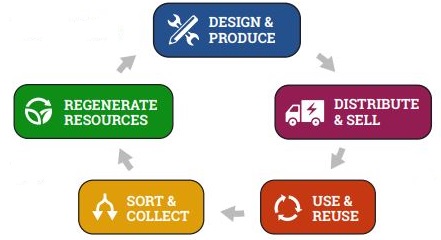Materials-Climate Nexus
The Circular Economy
In a linear economy, natural resources are extracted from the environment and transformed into products that are consumed and ultimately disposed as waste. A recycling economy is better, but only addresses what we do with materials at their "end of life." A circular economy aims to eliminate waste and close the loop through product design and innovative business models, continuously cycling materials through
Materials and Embodied Carbon
Materials-Climate Nexus Priorities
Circular Economy
The Ellen MacArthur Foundation is a leading nonprofit organization working to accelerate the transition to a circular economy. StopWaste is a Ellen MacArthur Foundation Circular Economy 100 USA member.
In this capacity, we've partnered with Arup to explore how local governments can use circular economy principles to improve buildings and communities.
Read our one-page topic brief: The Circular Economy
Download our primer: Circular Economy in the Built Environment: Opportunities for Local Government Leadership
Construction & Demolition Materials
When wood, cardboard and other organic C&D debris are landfilled instead of recycled, they break down and produce methane, a potent greenhouse gas.
Our C&D Debris section provides information about C&D waste reduction, reuse and recycling.
Model Policy for Reducing the Embodied Emissions of Concrete
StopWaste is partnering with the County of Marin and other Bay Area local governments to seek funding for a proposed project that would increase demand for low-carbon concrete. The project would drive demand through policy by developing template building codes and technical performance specifications for low embodied carbon concrete.
Of all building materials, Portland cement - one of the primary components of concrete - has a particularly intense impact on the climate. Carbon dioxide emitted from cement production is the second largest source of industrial CO2 emissions in the United States. There is technology now available that can easily reduce the embodied carbon of concrete by more than half. The technology is established but demand has not scaled.
Composting
Composting food waste reduces CO2e emissions by about 0.4 tons of CO2e compared to landfilling. StopWaste has promoted backyard and commercial composting for decades. All cities in Alameda County provide residential curbside collection of food scraps, food soiled paper and plant debris.
Under the Mandatory Recycling Ordinance, commercial compost collection is required for certain businesses and multifamily housing.
The Plant Debris Landfill Ban Ordinance prohibits disposal of plant debris in county landfills.
Reducing Food Waste
Preventing 1 ton of food waste reduces CO2e emissions by about 2 tons. The StopFoodWaste campaign provides food planning and storage tips to help people reduce food waste at home.
StopWaste's Smart Kitchen Initiative helps mid- to high-volume food service operators in Alameda County measure and prevent food waste.
Healthy Soil
A half inch layer of compost applied to the soil sequesters about 1 ton of CO2e per hectare of applied land. StopWaste provides technical assistance and other resources to encourage its member agencies and landscape professionals to improve soil health by applying compost and mulch. StopWaste's Climate Change Adaptation Measures report lists nearly 50 healthy soils-related measures that can be incorporated in climate action plans.
These StopWaste projects are helping to reduce packaging waste and associated GHG emissions:
Reusable Bag Ordinance. In Alameda County, retailers are not allowed to provide single-use plastic carryout bags at checkout. Survey data shows:
- 80% decline in stores' use of single-use paper and plastic bags
- 200% increase in the number of shoppers bringing reusable bags or not using bags
- 44% decrease in plastic bags found in County storm drains
- 90+% compliance rate by stores
Use Reusables. This StopWaste campaign helps businesses replace limited-life transport packaging material with durable, reusable transport packaging. This saves businesses money and lowers energy use and GHG emissions associated with manufacturing disposable packaging.
Packaging Design and Labeling. StopWaste works with local consumer products companies to optimize packaging design, apply life-cycle thinking to packaging decisions, and choose labeling - such as the How2Recycle label - that increases recycling rates.
Reduce Disposable Food Ware. StopWaste's Rethink Disposable program helps businesses and schools obtain rebates, switch to reusable food ware, and embrace other practices that prevent waste in food service.